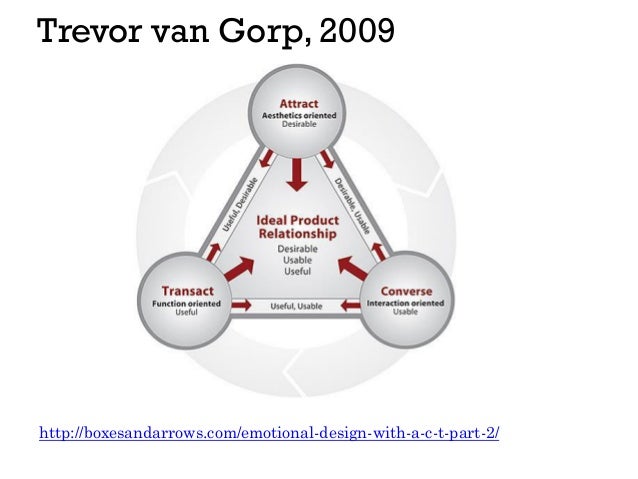A designer’s ability to provide satisfaction through aesthetic appeal and pleasure can greatly influence the success of a product, service or system. Understanding attitudes, expectations and motivations of consumers plays a significant role in predicting product interaction. Designers need to be empathetic and sympathetic to user emotion, which acts as a critical component to determine how he or she interprets and interacts with a product, service or system.
The ability to express emotion through a product can not only build appeal for the consumer, but also build affinity between a product and consumer. It can enable a product to communicate how one should interact with it.
Why Design for Pleasure/Emotion
Online book from ScienceDirect on Design for Emotion.
- Attitude: The perceptions, feelings and opinions about a product by a user.
- We want to create products that people love.
- To make it a pleasure to use – reduce complexity – it’s usable!
- People become ‘attached’ to a product
- Engage the user/consumer in the product
- This will also develop brand loyalty
- if a consumer is satisfied with the product, they’ll come back
- Increase or maintain sales for a company
- and Mr T says ‘its just nice’ (don’t write this bullet on your exam)
The four-pleasure framework
The four-pleasure framework was identified by Professor Lionel Tiger from Rutgers University in New Jersey, USA. It includes the following areas.
Socio-pleasure
- Is derived from social interaction.
- Products and services can facilitate social interaction in a number of ways.
- Examples include:
- Email, internet and mobile phones that facilitate communication between people.
- Products may promote social interaction by being conversation starters, for example, jewelry, artwork or furniture.
- Clothing can communicate social identity and indicate that a person belongs to a particular social group.
Physio-pleasure
- Is derived from the feel of a product during use
- Examples include:
- wearing a silk garment or the smooth feel of an iPod/iPhone,
- taste such as eating chocolate
- smell of leather, a new car, coffee or freshly baked bread
Psycho-pleasure
- Is derived from the cognitive demands of using a product or service and the emotional reactions engendered through the experience of using it.
- The outcome may also be more emotionally satisfying and less stressful.
- Examples include:
- it might be expected that a word processor that facilitated quick and easy accomplishment of tasks would provide a higher level of psycho-pleasure than one with which the user was likely to make many errors. The former word processor should enable the user to complete the task more easily than he or she would with the latter.
Ideo-pleasure
- Is derived from products that are aesthetically pleasing by appealing to the consumer’s values.
- Values could be philosophical or religious or may relate to some particular issue such as the environment or a political movement.
- These values can be embodied in products.
- Examples include:
- A product made from biodegradable materials might be seen as embodying the value of environmental responsibility.
Design for emotion
Designing for emotion can increase:
- User engagement
- Product or brand loyalty
- Satisfaction with a product by incorporating emotion and personality
- Visceral design: Design that speaks to people’s nature in terms of how they expect products and systems to function and how they expect to interact with them.
- Reflective Design: Design that evokes personal memory focussing on the message, culture and the meaning of a product or its use.
-
Behavioural design: Focussed on use and understanding, this considers how people will use a product, focussing on functionality.
This is a good website going into more depth from Usabilla.
The attract/converse/transact (ACT) model
How the ACT model can be used as a framework for creating designs that intentionally trigger positive emotional responses
Attract/Converse/Transact (ACT) model (Van Gorp, Adams 2012)* is a framework for creating designs that improve the relations of users with a product and intentionally trigger emotional responses.
-
- The attract part of the model is aesthetics oriented.
-
- The converse part of the model is interaction oriented.
- The transact part of the model is function oriented.
When all three elements are addressed, products can become desirable, usable and useful.
*Van Gorp, T and Adams, E. 2012. Design for Emotion. Waltham, Massachusetts, USA. Morgan Kaufman.
Theory of Knowledge
Are emotions purely physiological or are they culturally bound?



